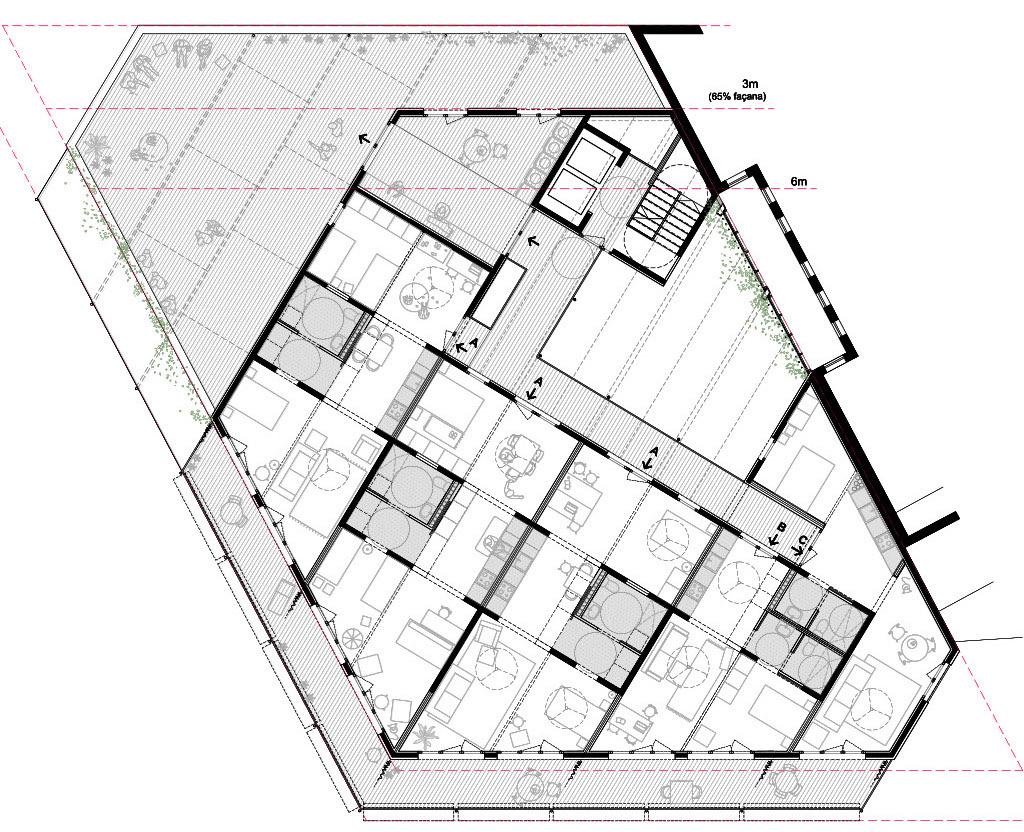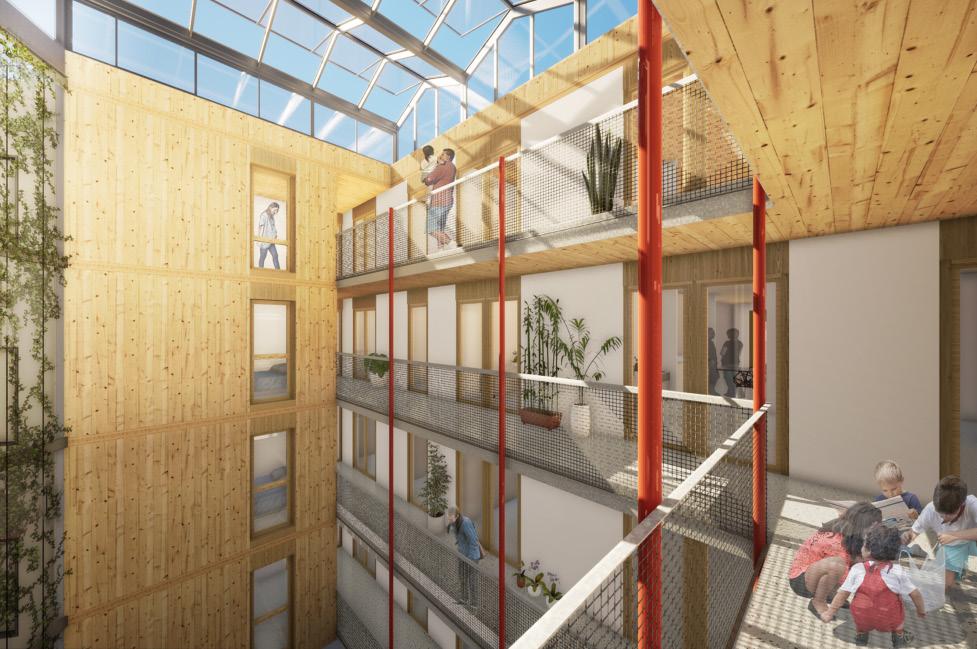
5 minute read
Towardsreplication
In the case of Sotrac26, due to the online access to the documents of its first proposal drawings and renders, we are more in position to compare Sotrac as a sociospatial configurations in relation to its protocol model, La Borda. Some of the elements that made La Borda to stand out as innovative final project are: the atrium, the communal spaces, the corridor, the relation to the Can Batlló site and the broader neighborhood of La Bordeta, and the housing units.
More in details, it seems that the project of Sotrac will have three facades, making it a bit more extrovert than in the case of La Borda. Evidence to that, it is also the reduced size of the atrium here, reducing its centrality as a reference point for the future community of Sotrac. Therefore, the corridor, which is the intermediate space between the atrium and the housing units, is not anymore a central distribution but more as linear infrastructure –not resembling so much to the reference to the traditional corralas. Moreover, the intimacy of the housing units is in direct contact with the publicness of the corridor, since there is no relevant space which acts as a threshold in each pair of units -like in the case of La Borda. Despite the lack of centrality, Sotrac seems to have enough of communal space, both on the ground floor and the fifth floor. Although, those community spaces have no longer optical connection between them. Questions such as maintenance are arisen here, especially for the space on the fifth floor. The success in the project of La Borda is that all communal spaces are physically and visibly accessible bringing more social awareness and feeling of domestic care among the community. Similar to La Borda, the local commercial facility is closer to the public street (main façade), giving to the ground floor’s communal services more
Advertisement
The floor plan of the of the source: Lacol (n.d.) SOTRAC HABITATGE COOPERATIU [EN PROGRÉS], drawing, Lacol, Available at: https:// www.lacol.coop/projectes/ sotrac-habitatge-cooperatiu/ (Accessed: 26 January 2023). source: Lacol (n.d.) SOTRAC HABITATGE COOPERATIU [EN PROGRÉS], image, Lacol, Available at: https:// www.lacol.coop/projectes/ sotrac-habitatge-cooperatiu/ (Accessed: 26 January 2023). space towards the other two facades, creating direct connection to the community of Can Batlló. And by that, defining for them the relations between the micro-community of Sotrac and the macro-community of Can Batlló and La Bordeta.
A rendered image, showing the atrium of the future CHP of Sotrac, with the some of the housing units facing to it.

In addition, the relation between the number and the surface of the housing units here is denser than La Borda –and to be precise, from 28 units in La Borda to 38 here. Probably the result of a compromise between the city’s regulation and the successful standardization of the housing unit to the needs of the community. What is interesting though here, is the flexibility of the limits of each unit, making it capable to be expanded towards a neighboring one in case of change in the situation of the members, like in La Borda. Marc an active member of La Dinamo –responsible for the promotion and financial and technical support for CHP- reassures that. He adds that “New forms of living are created to cover the needs of the people and to make it more accessible”. He mentions that “Internationality is one of the main keys. In case that a child in the future wants to have a bigger room or their own housing unit with their own family, they can exchange units between the different ones of Sotrac, or even among members in other CHP in Can Batlló!” Sotrac is a community infrastructure that will act as a node in a bigger network of social economy, regenerating common space by giving the opportunity to the community to welcome other commoners beyond the scale of the CHP.
The community of Can Batlló managed in 2021 to take one more plot in the postindustrial area from the Barcelona City Council with the same process of land use rights. Empriu27 will therefore be the third housing cooperative in Can Batlló, joining La Borda and Sotrac. And for its realization is responsible, once again, the architectural cooperative Lacol.
Despite of the lack of online documents for the first proposal from Lacol for the CHP
27. La Dinamo (2021) Empriu. Available at: https:// ladinamofundacio.org/project/ empriu/ (Accessed: 10 January 2023).
28. «This was not the case with the collaborative housing projects they did afterwards. They were involved in this purely professionally and only participated in a few meetings. In addition, they spent more time on La Borda as it was the first project of its kind, and they lacked the experience and expertise. They eventually learned a lot through trial and error. For example, they regret the large degree of selfconstruction and that they have not engaged a single contractor.” of Empriu, I had the chance to have some insight to the behind-the-scenes process from the side of the future residents. Mr. Marc as member of Empriu and future resident –who has been present through the project of La Borda and who now is an active member of La Dinamo- explains that there are problems of the financing of the project and the bureaucracy of Barcelona and Catalonia. “Like the case of Sotrac, we had to increase the number of housing units by 14. There are still gaps in the legislator system. On top of that, there is not so much financial support for the development of the project and its construction”, he explains.
Source: Czischke, D. (2022) “The role(s) of the architect in collaborative housing”, Co-Lab Research. Accessible at: https:// co-lab-research.net/tag/livingtogether/ (Accessed at: 12 January 2023).
Later, he reassures that Lacol participates in their assemblies as they did in La Borda but less frequently. “There is an architecture committee but now they want to make their practices of collaboration and processes with cooperatives like us more professionalized”. He continues by adding that Lacol wants to reduce cost by developing techniques which promote more self-construction during the construction process of the building. One reason, the financial aspect. Maybe, another reason, is that the community participation in the construction process as common space creates bonds and better integrality in the future dwelling. It is true that challenges during La Borda’s construction, including allocation of the apartments, intense work periods with high stress levels, and negotiations with external organizations took place. Although, Darinka criticize the practices of Lacol in their online article called “The role(s) of the architect in collaborative housing”28, mentioning that the architectural cooperative attended less mutual participation with Empriu.
Questions are arising here, though. Is the more-than-10-years collaboration of Lacol with Can Batlló, enough to replace any future possible architectural committees with new cooperative of the community there? Can they regenerate responsible community infrastructures genuine to the needs and identity to the future residents with less collaboration? Is the interdisciplinary information and expertise gathered in their workspace La Comunal replacing the community participation with each of the future CHP?
No matter what the answer is, one thing is clear: Can Batlló is being progressively reclaimed back by its citizens. La Borda’s catalytic role to that cannot be questioned. Their contribution to processes of commoning and materialization of the demands of housing activism from the early stage up to now are significant. Although, nowadays, the surrounding area of Can Batlló counts more than 500 luxury apartments, which are threatening the sustainability of the post-industrial site. A contradiction between locals that are seeking for decent housing and rich people with no connection to the area and its history, as Marc worries about. Are the neoliberal practices will progressively engulf more and more plots of Can Batlló, leaving for the proletariat community only some scattered leftovers? The safety of common space that La Borda shared among other commoners-citizens for developing together processes and infrastructures of commoning is under constant threat and evolution.










